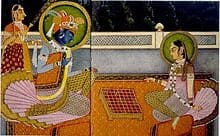
- Chess World Cup
- FIDE Grand Prix
- Olympiad
- World Championship
- List of strong tournaments
- List of world championships

- Checkmate patterns
- Chess openings
- Chess strategy
- Chess tactics
- Chess theory
- Endgames
- Pawn structure
- Problems/Compositions












 |
a | b | c | d | e | f | g | h |  |
| 8 |  |
 |
 |
 |
 |
 |
 |
 |
8 |
| 7 |  |
 |
 |
 |
 |
 |
 |
 |
7 |
| 6 |  |
 |
 |
 |
 |
 |
 |
 |
6 |
| 5 |  |
 |
 |
 |
 |
 |
 |
 |
5 |
| 4 |  |
 |
 |
 |
 |
 |
 |
 |
4 |
| 3 |  |
 |
 |
 |
 |
 |
 |
 |
3 |
| 2 |  |
 |
 |
 |
 |
 |
 |
 |
2 |
| 1 |  |
 |
 |
 |
 |
 |
 |
 |
1 |
 |
a | b | c | d | e | f | g | h |  |
Chaturanga (Sanskrit: चतुरङ्ग; caturaṅga), catur, is an ancient Indian strategy game which is the common ancestor of the board games chess, shogi, makruk, xiangqi and janggi.
Chaturanga developed in the Gupta Empire, India around the 6th century AD. In the 7th century, it was adopted as shatranj in Sassanid Persia, which in turn was the form of chess brought to late-medieval Europe.
The exact rules of chaturanga are unknown. Chess historians suppose that the game had similar rules to those of its successor shatranj. In particular, there is uncertainty as to the moves of the Gaja (elephant), the precursor of the modern chess bishop.
 Krishna and Radha playing chaturanga on an 8x8 Ashtāpada
Krishna and Radha playing chaturanga on an 8x8 AshtāpadaSanskrit caturaṅga is a bahuvrihi compound, meaning "having four limbs or parts" and in epic poetry often means "army". The name comes from a battle formation mentioned in the Indian epic Mahabharata, referring to four divisions of an army, namely elephants, chariots, cavalry and infantry. An ancient battle formation, Akshauhini, is like the setup of chaturanga.
 |
a | b | c | d | e | f | g | h |  |
| 8 |  |
 |
 |
 |
 |
 |
 |
 |
8 |
| 7 |  |
 |
 |
 |
 |
 |
 |
 |
7 |
| 6 |  |
 |
 |
 |
 |
 |
 |
 |
6 |
| 5 |  |
 |
 |
 |
 |
 |
 |
 |
5 |
| 4 |  |
 |
 |
 |
 |
 |
 |
 |
4 |
| 3 |  |
 |
 |
 |
 |
 |
 |
 |
3 |
| 2 |  |
 |
 |
 |
 |
 |
 |
 |
2 |
| 1 |  |
 |
 |
 |
 |
 |
 |
 |
1 |
 |
a | b | c | d | e | f | g | h |  |
Chaturanga was played on an 8x8 uncheckered board, called Ashtāpada. The board sometimes had special markings, the meaning of which is unknown today. These marks were not related to chaturanga, but were drawn on the board only by tradition. Chess historian H. J. R. Murray conjectured that the Ashtāpada was also used for some old race-type dice game, perhaps similar to Chowka bhara, in which the marks had meaning.
An early reference to an ancient Indian board game is sometimes attributed to Subandhu in his Vasavadatta (c. AD 450):
The time of the rains played its game with frogs for pieces [nayadyutair] yellow and green in colour, as if mottled by lac, leapt up on the black field squares.
The colours are not those of the two camps, but mean that the frogs have a two-tone dress, yellow and green.
Banabhatta's Harsha Charitha (c. AD 625) contains the earliest reference to the name chaturanga:
Under this monarch, only the bees quarrelled to collect the dew; the only feet cut off were those of measurements, and only from Ashtâpada one could learn how to draw up a chaturanga, there was no cutting-off of the four limbs of condemned criminals...
While there is little doubt that Ashtâpada is the gameboard of 8x8 squares, the double meaning of chaturanga, as the four-folded army, may be controversial. There is a probability that the ancestor of chess was mentioned there.
The game was first introduced to the West in Thomas Hyde's De ludis orientalibus libri duo, published in 1694. Subsequently, translations of Sanskrit accounts of the game were published by Sir William Jones.
In Arabic, most of the terminology was carried out directly from chaturanga: modern chess itself is called "chitranj" in Arabic, and the bishop is called "elephant".
The initial position is as shown. White moves first. The objective in chaturanga, the same as modern chess, is to checkmate the opponent's Raja (king).
| Chaturanga pieces | |
|---|---|
  |
Raja (king) |
  |
Mantri or Senapati (counselor or general; ancestor of ferz; early form of queen) |
  |
Ratha (chariot; rook) |
  |
Gaja (elephant; later called fil; early form of bishop) |
  |
Ashva (horse; knight) |
  |
Padàti or Bhata (foot-soldier or infantry; pawn) |
Al-Adli mentions two further differences: